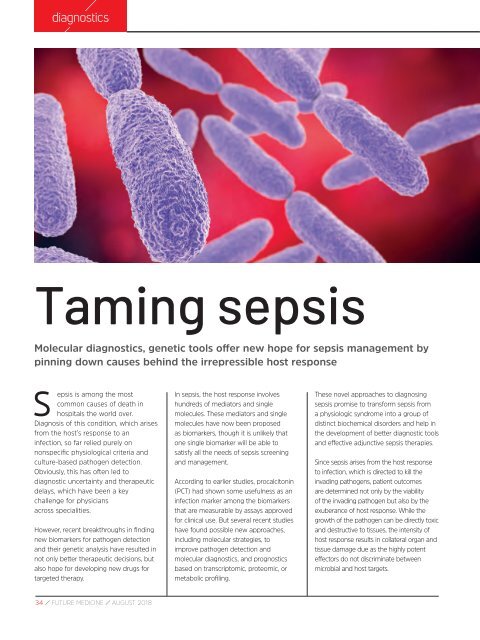FM AUGUST 2018 ISSUE1 - digital edition
You also want an ePaper? Increase the reach of your titles
YUMPU automatically turns print PDFs into web optimized ePapers that Google loves.
diagnostics<br />
Taming sepsis<br />
Molecular diagnostics, genetic tools offer new hope for sepsis management by<br />
pinning down causes behind the irrepressible host response<br />
S<br />
epsis is among the most<br />
common causes of death in<br />
hospitals the world over.<br />
Diagnosis of this condition, which arises<br />
from the host’s response to an<br />
infection, so far relied purely on<br />
nonspecific physiological criteria and<br />
culture-based pathogen detection.<br />
Obviously, this has often led to<br />
diagnostic uncertainty and therapeutic<br />
delays, which have been a key<br />
challenge for physicians<br />
across specialities.<br />
However, recent breakthroughs in finding<br />
new biomarkers for pathogen detection<br />
and their genetic analysis have resulted in<br />
not only better therapeutic decisions, but<br />
also hope for developing new drugs for<br />
targeted therapy.<br />
In sepsis, the host response involves<br />
hundreds of mediators and single<br />
molecules. These mediators and single<br />
molecules have now been proposed<br />
as biomarkers, though it is unlikely that<br />
one single biomarker will be able to<br />
satisfy all the needs of sepsis screening<br />
and management.<br />
According to earlier studies, procalcitonin<br />
(PCT) had shown some usefulness as an<br />
infection marker among the biomarkers<br />
that are measurable by assays approved<br />
for clinical use. But several recent studies<br />
have found possible new approaches,<br />
including molecular strategies, to<br />
improve pathogen detection and<br />
molecular diagnostics, and prognostics<br />
based on transcriptomic, proteomic, or<br />
metabolic profiling.<br />
These novel approaches to diagnosing<br />
sepsis promise to transform sepsis from<br />
a physiologic syndrome into a group of<br />
distinct biochemical disorders and help in<br />
the development of better diagnostic tools<br />
and effective adjunctive sepsis therapies.<br />
Since sepsis arises from the host response<br />
to infection, which is directed to kill the<br />
invading pathogens, patient outcomes<br />
are determined not only by the viability<br />
of the invading pathogen but also by the<br />
exuberance of host response. While the<br />
growth of the pathogen can be directly toxic<br />
and destructive to tissues, the intensity of<br />
host response results in collateral organ and<br />
tissue damage due as the highly potent<br />
effectors do not discriminate between<br />
microbial and host targets.<br />
34 / FUTURE MEDICINE / <strong>AUGUST</strong> <strong>2018</strong>


















